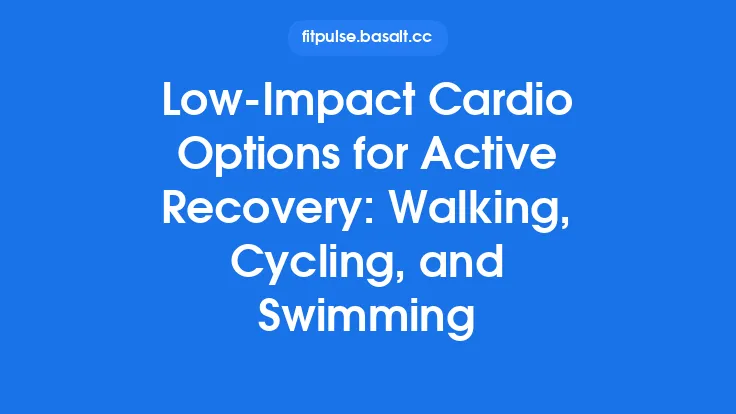Running, cycling, and swimming each place distinct mechanical, metabolic, and neuromuscular stresses on the body. When an athlete is recovering from injury, a one‑size‑fits‑all return‑to‑play (RTP) plan can leave critical gaps that increase the risk of re‑injury or prolonged performance loss. By tailoring the progression to the specific demands of each sport, clinicians, coaches, and athletes can rebuild the exact qualities—stride mechanics, pedal force application, or stroke efficiency—that were compromised, while respecting the tissue healing timeline. This article walks through the core components of sport‑specific RTP for runners, cyclists, and swimmers, offering evergreen guidance that can be adapted to a wide range of injury types and performance levels.
Understanding the Unique Demands of Running, Cycling, and Swimming
| Aspect | Running | Cycling | Swimming |
|---|---|---|---|
| Primary kinetic chain | Lower‑body (hip‑knee‑ankle) with high impact forces | Lower‑body and core, repetitive concentric pedal strokes, low impact | Full‑body (shoulder‑core‑leg) with continuous propulsive and resistive phases, low impact |
| Energy system emphasis | Predominantly aerobic with intermittent anaerobic bursts (sprints, hills) | Aerobic with sustained sub‑maximal power; occasional high‑intensity intervals | Aerobic with high reliance on efficient stroke technique to minimize drag |
| Typical loading pattern | Ground reaction forces up to 2–3 × body weight per step | Continuous torque generation; peak pedal force 30–40 % of body weight | Cyclical drag forces; peak shoulder torque 10–15 % of body weight |
| Key performance metrics | Pace, stride length/frequency, ground contact time | Power output (watts), cadence, torque symmetry | Stroke rate, stroke length, swim velocity, turn time |
Recognizing these biomechanical and physiological signatures is the first step in designing a sport‑specific RTP plan. For example, a runner recovering from a tibial stress fracture must prioritize impact attenuation and stride symmetry, whereas a cyclist returning from a knee meniscus repair must focus on pedal force distribution and hip‑knee coordination. Swimmers with shoulder impingement need to restore scapular rhythm and streamline position before re‑introducing high‑intensity intervals.
Common Injuries and Their Implications for Return‑to‑Play
| Sport | Frequent Injuries | RTP Implications |
|---|---|---|
| Running | Plantar fasciitis, Achilles tendinopathy, IT‑band syndrome, stress fractures, patellofemoral pain | Need for progressive impact loading, gait retraining, and calf‑Achilles flexibility |
| Cycling | Patellofemoral pain, iliotibial band friction, low‑back strain, hip flexor tendinopathy, knee meniscus tears | Emphasis on pedal stroke symmetry, saddle positioning, and core stability |
| Swimming | Shoulder impingement, rotator cuff tendinopathy, lumbar stress fractures, knee “breaststroke” strain | Restoration of scapular‑humeral rhythm, core‑leg coordination, and controlled breathing patterns |
While the article does not replace a detailed injury‑specific protocol, understanding the typical biomechanical deficits associated with each injury informs the selection of sport‑specific drills, load increments, and technical cues during the RTP phases.
Baseline Assessment Specific to Each Discipline
A sport‑specific baseline establishes the athlete’s functional starting point and highlights asymmetries that may have emerged during injury.
Running: Conduct a treadmill gait analysis at 70 % of pre‑injury pace, measuring stride length, vertical oscillation, and ground reaction forces via force plates or wearable insoles. Include a single‑leg hop test to gauge limb‑specific power.
Cycling: Perform a stationary bike power test at a standardized cadence (e.g., 90 rpm) while recording left‑right torque balance using a power meter. Assess hip‑knee‑ankle range of motion in the seated and standing positions, and evaluate saddle‑to‑handlebar reach for ergonomic alignment.
Swimming: Use a video analysis of a 25‑m swim at a comfortable pace to capture stroke count, stroke length, and shoulder rotation angles. Implement a dry‑land “pull‑up” test with a resistance band to quantify scapular upward rotation and external rotation strength.
These assessments should be repeated at the end of each RTP phase to quantify progress and guide load adjustments.
Phase 1: Re‑Establishing Fundamental Movement Patterns
The initial phase focuses on low‑impact, low‑intensity activities that reinforce proper motor patterns without overloading healing tissues.
- Running: Begin with brisk walking or treadmill walking on a soft surface (e.g., grass, rubberized track) for 10–15 minutes, emphasizing mid‑foot strike and neutral pelvis. Incorporate “marching” drills that isolate hip extension and knee lift.
- Cycling: Use a stationary trainer with a low resistance setting (≈30 % of FTP – Functional Threshold Power). Pedal at 80–90 rpm for 10 minutes, concentrating on a smooth “circle” motion and equal force application throughout the crank cycle.
- Swimming: Perform “streamline glides” and “kick‑board” drills at a relaxed pace, focusing on body alignment and rhythmic breathing. Use a pull buoy to isolate the upper body while maintaining a neutral spine.
During this phase, the athlete should experience no pain beyond mild soreness, and any increase in swelling or joint effusion should prompt a step back to the previous activity level.
Phase 2: Re‑Introducing Sport‑Specific Load
Once fundamental patterns are stable, the next step is to add controlled, sport‑specific stressors. Load progression should follow a 10 % rule per week (i.e., increase volume or intensity by no more than 10 % of the previous week) while monitoring symptom response.
- Running: Transition to a run‑walk protocol (e.g., 2 min run/1 min walk) on a forgiving surface, gradually extending the running intervals. Introduce gentle hills (≤2 % grade) to stimulate eccentric quadriceps loading without excessive impact.
- Cycling: Increase resistance to 50 % of FTP and add short intervals (30 seconds at 80 % FTP) interspersed with 2‑minute recovery spins. Incorporate standing climbs for brief periods to engage gluteal and hamstring activation.
- Swimming: Add interval sets such as 4 × 50 m at 70 % effort with 30 seconds rest, focusing on maintaining stroke length. Introduce “catch‑up” drills to reinforce proper hand entry and pull phase timing.
Throughout Phase 2, athletes should log perceived exertion, pain levels, and any mechanical changes (e.g., altered foot strike or pedal stroke). This data informs whether the weekly load increase is appropriate or if a regression is needed.
Phase 3: Restoring Technical Efficiency and Economy
Efficiency is the bridge between safe load tolerance and competitive performance. At this stage, the emphasis shifts from “can I do it?” to “how well can I do it?”
- Running: Implement cadence drills (e.g., 180 steps per minute metronome) and “drills” such as high‑knees, butt‑kicks, and A‑skips to reinforce neuromuscular timing. Use a lightweight shoe with minimal cushioning to promote proprioceptive feedback, but only after confirming adequate impact tolerance.
- Cycling: Conduct “pedal stroke analysis” using a power meter to identify dead spots (0–90° and 180–270° crank angles). Apply targeted drills—single‑leg pedaling, high‑cadence spin‑ups (100–110 rpm) for 30 seconds—to smooth the torque curve. Adjust bike fit (saddle height, fore-aft position) based on observed hip‑knee‑ankle angles to reduce undue joint stress.
- Swimming: Focus on “stroke efficiency” metrics such as Stroke Index (SI = speed × stroke length) and “propulsive phase” duration. Use tempo trainers to fine‑tune breathing patterns (e.g., 3‑stroke breathing) and incorporate “sculling” drills to enhance hand‑water interaction.
Video feedback, wearable sensors, or coach observation can be employed to provide immediate corrective cues, accelerating the re‑acquisition of sport‑specific technique.
Phase 4: Simulating Competition Conditions
The final RTP stage replicates the physiological and psychological demands of competition while maintaining a safety net.
- Running: Schedule a “race‑pace” run of 75 % of the target distance on a mixed‑terrain course, including turns, slight elevations, and surface changes. Follow with a brief cool‑down and post‑run assessment of joint pain and swelling.
- Cycling: Perform a “time‑trial simulation” of 20–30 minutes at 85–90 % of FTP on a road or indoor course that includes varied gradients and wind resistance (if possible). Include a sprint finish to test neuromuscular readiness.
- Swimming: Conduct a “race set” such as 8 × 100 m at target race pace with 15 seconds rest, incorporating starts, turns, and finishes. Evaluate stroke count consistency and turn speed.
If the athlete completes these simulations without exacerbated symptoms, demonstrates stable technique, and reports confidence in the activity, they are considered ready for full competition participation.
Monitoring Tools Tailored to Each Sport
| Sport | Objective Metric | Practical Tool |
|---|---|---|
| Running | Ground reaction force, stride symmetry | Wearable insoles (e.g., Loadsol), GPS watch with cadence sensor |
| Cycling | Power balance, pedal smoothness | Dual‑sided power meter, crank torque analysis software |
| Swimming | Stroke efficiency, shoulder torque | Underwater video analysis, wearable swim metrics (e.g., FINIS) |
In addition to these sport‑specific tools, a universal Recovery‑Readiness Score (combining resting heart rate variability, sleep quality, and perceived wellness) can help fine‑tune daily training loads across all three disciplines.
Nutrition and Hydration Strategies for Accelerated Recovery
While not a direct training variable, nutrition underpins tissue repair and energy restoration.
- Protein: Aim for 1.6–2.2 g·kg⁻¹·day⁻¹, distributed in 20–30 g portions every 3–4 hours to support muscle protein synthesis.
- Omega‑3 Fatty Acids: 2–3 g EPA/DHA daily may attenuate inflammation, beneficial for tendon and joint recovery.
- Carbohydrates: During Phase 2–4, consume 5–7 g·kg⁻¹·day⁻¹ to replenish glycogen stores, especially before high‑intensity intervals.
- Hydration: Monitor urine color and body mass changes pre/post session. For swimmers, consider electrolyte‑enhanced fluids to offset sweat losses that are often underestimated in water.
Tailoring macronutrient timing to the specific training session (e.g., carbohydrate‑protein blend within 30 minutes post‑run) can expedite recovery and improve subsequent performance.
Return‑to‑Play Decision Matrix for Each Discipline
| Criterion | Running | Cycling | Swimming |
|---|---|---|---|
| Pain | ≤ 2/10 on VAS during and after a 30‑min run at 80 % target pace | ≤ 2/10 during a 45‑min ride at 85 % FTP, no pain on pedal stroke analysis | ≤ 2/10 during a 30‑min swim at race pace, no pain on shoulder rotation |
| Swelling/Edema | No visible swelling after a 24‑hour post‑run check | No joint effusion after a 48‑hour post‑ride check | No shoulder or knee swelling after a 24‑hour post‑session check |
| Technical Consistency | Stride length variation < 5 % between left/right | Pedal torque symmetry > 90 % | Stroke count variation < 3 % per 25 m |
| Performance Metric | Able to sustain target pace for ≥ 75 % of planned distance | Able to maintain target power for ≥ 80 % of interval duration | Able to hold target swim speed for ≥ 80 % of set |
| Physiological Response | HRV within 80 % of baseline, resting HR ≤ 5 bpm above normal | HRV within 80 % of baseline, lactate < 2 mmol·L⁻¹ after a sub‑max test | HRV within 80 % of baseline, perceived exertion ≤ 13 on Borg scale |
An athlete meeting all criteria in the matrix can be cleared for full competition. If any single element falls short, the plan should revert to the previous phase until the deficit resolves.
Practical Tips for Coaches and Athletes
- Document Daily Load – Use a simple spreadsheet or app to log distance, duration, intensity, and any pain or soreness notes.
- Schedule “Recovery Days” – Even in Phase 3, incorporate low‑impact cross‑training (e.g., pool jogging for runners, easy spin for cyclists) to maintain cardiovascular fitness without added stress.
- Communicate Across Disciplines – Athletes who cross‑train (e.g., a triathlete) should synchronize RTP plans to avoid cumulative overload.
- Use Cue‑Based Feedback – Verbal cues (“push through the mid‑stance” for runners, “smooth the dead spot” for cyclists, “keep the elbow high” for swimmers) reinforce neuromuscular patterns.
- Plan a “Return‑to‑Competition” Checklist – Include equipment inspection (shoe wear, bike drivetrain, swim cap), warm‑up routine, and mental rehearsal to ensure a smooth transition.
Frequently Asked Questions
Q: How long should each RTP phase last?
A: Duration varies with injury severity, tissue healing rate, and individual response. A typical timeline ranges from 2 weeks (minor soft‑tissue strain) to 8–12 weeks (stress fracture or post‑operative cases). Progression should be based on meeting the objective criteria of each phase rather than a fixed calendar.
Q: Can I use a treadmill for running RTP if I normally train on trails?
A: Yes, but incorporate at least one weekly session on a surface that mimics the competition terrain (e.g., grass or trail) once the athlete tolerates impact. This helps re‑condition proprioception and eccentric loading specific to uneven ground.
Q: Is it safe to add strength training during Phase 2?
A: Absolutely, provided the exercises are low‑load, high‑repetition, and do not exacerbate the injured area. For runners, focus on hip abductors and gluteal activation; cyclists benefit from core stability and single‑leg extensions; swimmers should prioritize scapular stabilizers and rotator cuff endurance.
Q: What if my athlete experiences a slight pain flare during a simulation?
A: A mild, transient pain (≤ 2/10) that resolves within 24 hours may be acceptable, but any pain that persists, worsens, or is accompanied by swelling should trigger a regression to the previous phase and a reassessment of load.
Q: How do I balance training for multiple sports (e.g., triathlon) during RTP?
A: Prioritize the sport with the most recent or severe injury for the first two phases, then gradually re‑introduce the other disciplines using the same load‑progression principles. Cross‑training should be limited to low‑impact modalities until the primary sport’s RTP criteria are met.
By respecting the distinct biomechanical demands of running, cycling, and swimming, and by applying a structured, data‑driven progression, athletes can return to competition with confidence, minimized re‑injury risk, and restored performance capacity.





